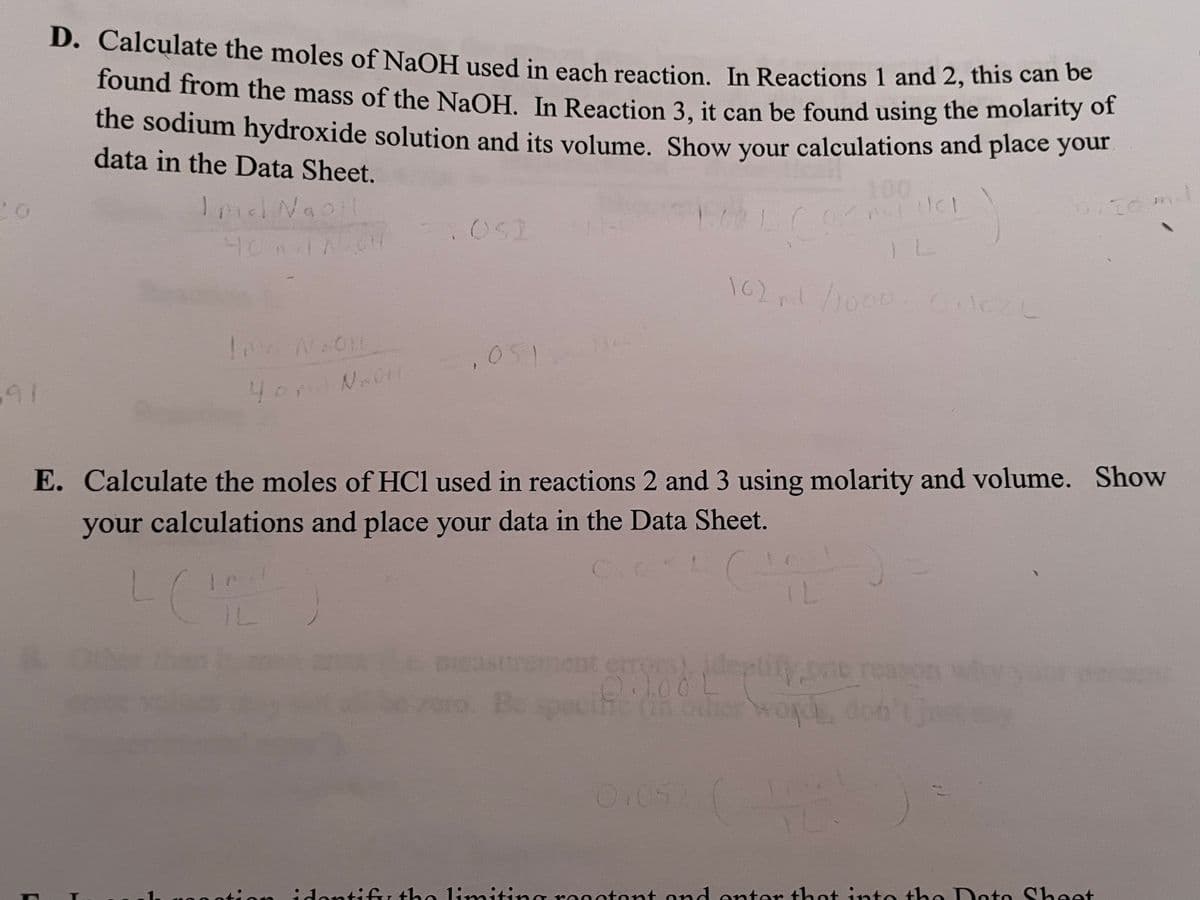91 D. Calculate the moles of NaOH used in each reaction. In Reactions 1 and 2, this can be found from the mass of the NaOH. In Reaction 3, it can be found using the molarity of the sodium hydroxide solution and its volume. Show your calculations and place your data in the Data Sheet. Imid NaOH 100 40 . OS2 Ind N2011 102,1/1000 Oilcl 4or Na011 1051 E. Calculate the moles of HCl used in reactions 2 and 3 using molarity and volume. Show your calculations and place your data in the Data Sheet. L trement errors), identify, one reason L (in other words, don't just 0.052 identif mit reactant ater that into Dato to She m
91 D. Calculate the moles of NaOH used in each reaction. In Reactions 1 and 2, this can be found from the mass of the NaOH. In Reaction 3, it can be found using the molarity of the sodium hydroxide solution and its volume. Show your calculations and place your data in the Data Sheet. Imid NaOH 100 40 . OS2 Ind N2011 102,1/1000 Oilcl 4or Na011 1051 E. Calculate the moles of HCl used in reactions 2 and 3 using molarity and volume. Show your calculations and place your data in the Data Sheet. L trement errors), identify, one reason L (in other words, don't just 0.052 identif mit reactant ater that into Dato to She m
Chemistry & Chemical Reactivity
10th Edition
ISBN:9781337399074
Author:John C. Kotz, Paul M. Treichel, John Townsend, David Treichel
Publisher:John C. Kotz, Paul M. Treichel, John Townsend, David Treichel
Chapter5: Principles Of Chemical Reactivity: Energy And Chemical Reactions
Section5.8: Product- Or Reactant-favored Reactions And Thermodynamics
Problem 2.1ACP
Related questions
Question

Transcribed Image Text:91
D. Calculate the moles of NaOH used in each reaction. In Reactions 1 and 2, this can be
found from the mass of the NaOH. In Reaction 3, it can be found using the molarity of
the sodium hydroxide solution and its volume. Show your calculations and place your
data in the Data Sheet.
Imid NaOH
100
40
. OS2
Ind N2011
102,1/1000 Oilcl
4or Na011
1051
E. Calculate the moles of HCl used in reactions 2 and 3 using molarity and volume. Show
your calculations and place your data in the Data Sheet.
L
trement errors), identify, one reason
L
(in other words, don't just
0.052
identif
mit
reactant
ater that into
Dato
to She
m
AI-Generated Solution
Unlock instant AI solutions
Tap the button
to generate a solution
Recommended textbooks for you

Chemistry & Chemical Reactivity
Chemistry
ISBN:
9781337399074
Author:
John C. Kotz, Paul M. Treichel, John Townsend, David Treichel
Publisher:
Cengage Learning


Chemistry: An Atoms First Approach
Chemistry
ISBN:
9781305079243
Author:
Steven S. Zumdahl, Susan A. Zumdahl
Publisher:
Cengage Learning

Chemistry & Chemical Reactivity
Chemistry
ISBN:
9781337399074
Author:
John C. Kotz, Paul M. Treichel, John Townsend, David Treichel
Publisher:
Cengage Learning


Chemistry: An Atoms First Approach
Chemistry
ISBN:
9781305079243
Author:
Steven S. Zumdahl, Susan A. Zumdahl
Publisher:
Cengage Learning

Chemistry
Chemistry
ISBN:
9781305957404
Author:
Steven S. Zumdahl, Susan A. Zumdahl, Donald J. DeCoste
Publisher:
Cengage Learning

Chemistry & Chemical Reactivity
Chemistry
ISBN:
9781133949640
Author:
John C. Kotz, Paul M. Treichel, John Townsend, David Treichel
Publisher:
Cengage Learning

General Chemistry - Standalone book (MindTap Cour…
Chemistry
ISBN:
9781305580343
Author:
Steven D. Gammon, Ebbing, Darrell Ebbing, Steven D., Darrell; Gammon, Darrell Ebbing; Steven D. Gammon, Darrell D.; Gammon, Ebbing; Steven D. Gammon; Darrell
Publisher:
Cengage Learning